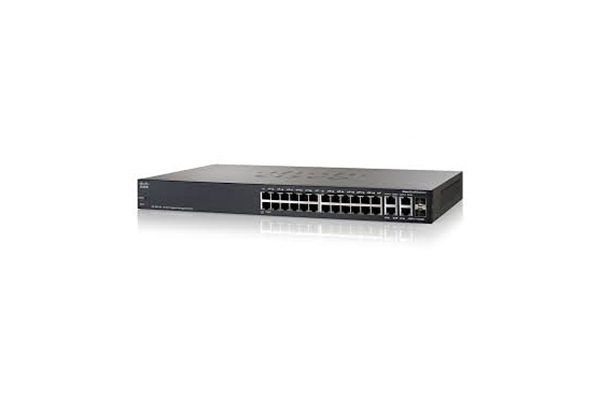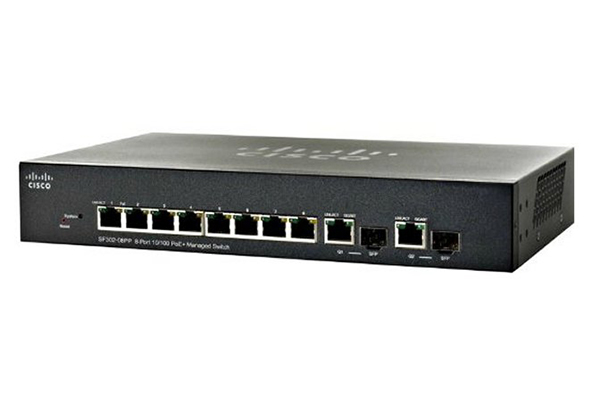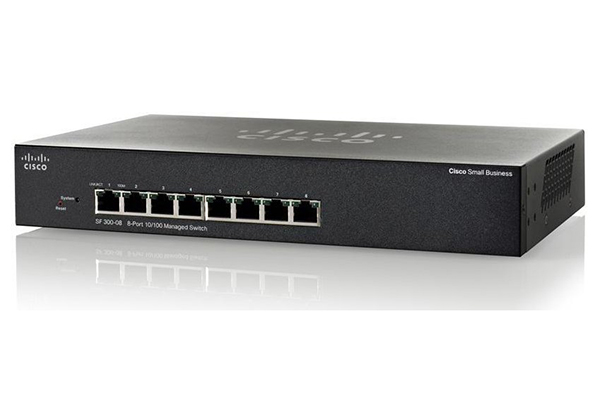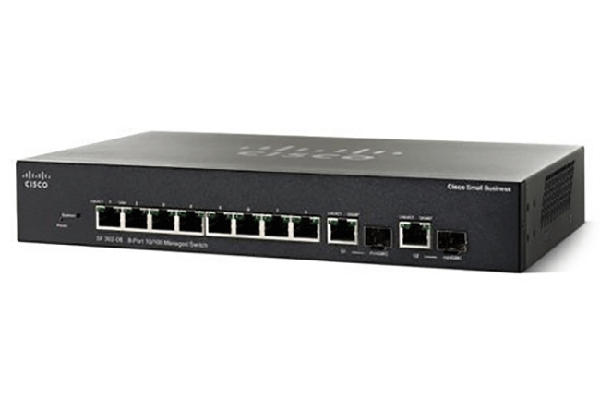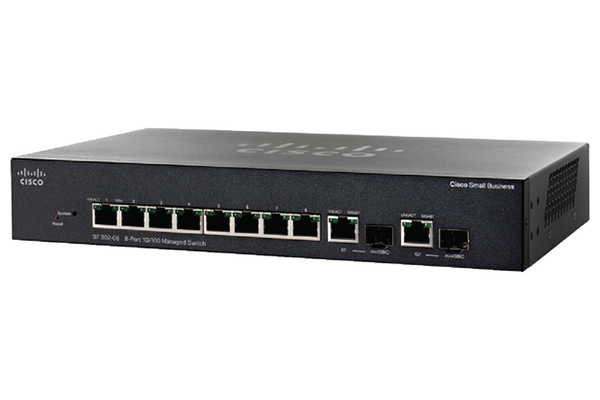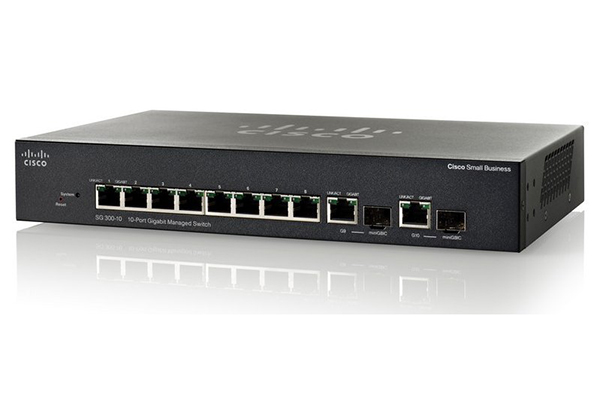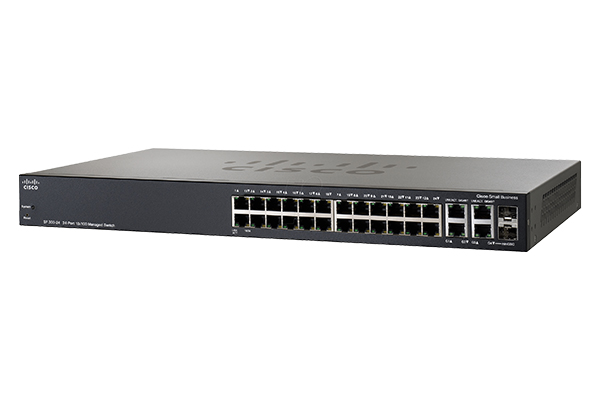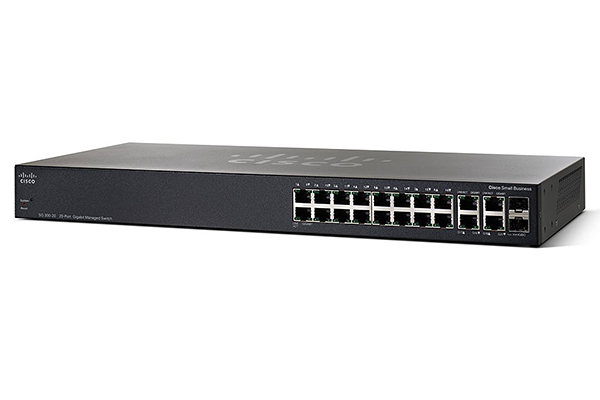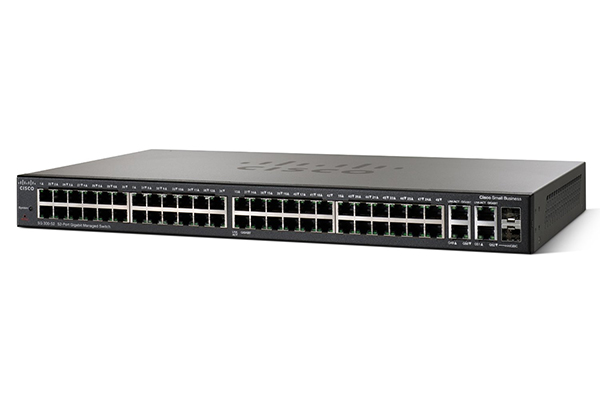CISCO SWITCH SG300-28 28-port Gigabit Managed Switch SRW2024-K9-EU
Giá: Liên hệ
Giới thiệu:
28-Port Gigabit Managed Switch CISCO SG300-28 (SRW2024-K9) - Product ID Number: SRW2024-K9
- 26 10/100/1000Mbps ports; 2 Combo mini-GBIC ports.
Tính năng kỹ thuật :
 26 10/100/1000 ports; 2 Combo mini-GBIC ports.
26 10/100/1000 ports; 2 Combo mini-GBIC ports.
 Performance: Switching capacity 56.0 Gbps, nonblocking, Forwarding rate 41.67 mpps wire-speed performance.
Performance: Switching capacity 56.0 Gbps, nonblocking, Forwarding rate 41.67 mpps wire-speed performance.
 Layer 2: Port grouping up to 8 ports per group with 16 candidate ports for each (dynamic) 802.3ad link aggregation, Number of VLANs 256 active VLANs (4096 range), Head-of-line (HOL) blocking HOL blocking prevention.
Layer 2: Port grouping up to 8 ports per group with 16 candidate ports for each (dynamic) 802.3ad link aggregation, Number of VLANs 256 active VLANs (4096 range), Head-of-line (HOL) blocking HOL blocking prevention.
 Layer 3: IPv4 routing Wirespeed routing of IPv4 packets, Up to 32 static routes and up to 32 IP interfaces, Classless Inter-Domain Routing (CIDR) support for CIDR.
Layer 3: IPv4 routing Wirespeed routing of IPv4 packets, Up to 32 static routes and up to 32 IP interfaces, Classless Inter-Domain Routing (CIDR) support for CIDR.
 QoS: Priority levels 4 hardware queues, Scheduling Priority queuing and weighted round-robin (WRR), Queue assignment based on DSCP and class of service (802.1p/CoS).
QoS: Priority levels 4 hardware queues, Scheduling Priority queuing and weighted round-robin (WRR), Queue assignment based on DSCP and class of service (802.1p/CoS).
 26 10/100/1000 ports; 2 Combo mini-GBIC ports.
26 10/100/1000 ports; 2 Combo mini-GBIC ports.  Performance: Switching capacity 56.0 Gbps, nonblocking, Forwarding rate 41.67 mpps wire-speed performance.
Performance: Switching capacity 56.0 Gbps, nonblocking, Forwarding rate 41.67 mpps wire-speed performance.  Layer 2: Port grouping up to 8 ports per group with 16 candidate ports for each (dynamic) 802.3ad link aggregation, Number of VLANs 256 active VLANs (4096 range), Head-of-line (HOL) blocking HOL blocking prevention.
Layer 2: Port grouping up to 8 ports per group with 16 candidate ports for each (dynamic) 802.3ad link aggregation, Number of VLANs 256 active VLANs (4096 range), Head-of-line (HOL) blocking HOL blocking prevention.  Layer 3: IPv4 routing Wirespeed routing of IPv4 packets, Up to 32 static routes and up to 32 IP interfaces, Classless Inter-Domain Routing (CIDR) support for CIDR.
Layer 3: IPv4 routing Wirespeed routing of IPv4 packets, Up to 32 static routes and up to 32 IP interfaces, Classless Inter-Domain Routing (CIDR) support for CIDR.  QoS: Priority levels 4 hardware queues, Scheduling Priority queuing and weighted round-robin (WRR), Queue assignment based on DSCP and class of service (802.1p/CoS).
QoS: Priority levels 4 hardware queues, Scheduling Priority queuing and weighted round-robin (WRR), Queue assignment based on DSCP and class of service (802.1p/CoS).Thông số kỹ thuật của Switch Cisco SRW2024-K9
| Cisco Small Business SRW2024-K9 switch - 28 ports GE - Managed - desktop, rack-mountable | |
| Device Type | Switch - 28 ports - L3 - Managed |
| Enclosure Type | Desktop, rack-mountable 1U |
| Subtype | Gigabit Ethernet |
| Ports | 28 x 10/100/1000 + 2 x combo Gigabit SFP |
| Power Over Ethernet (PoE) | N/A |
| PoE Budget | N/A |
| Performance | Switching capacity : 56 Gbps ¦ Forwarding performance (64-byte packet size) : 41.67 Mpps |
| Capacity | ACL rules : up to 512 |
| MAC Address Table Size | 8K entries |
| Jumbo Frame Support | 10KB |
| Routing Protocol | Static IPv4 routing |
| Remote Management Protocol | SNMP 1, RMON 1, RMON 2, RMON 3, RMON 9, Telnet, SNMP 3, SNMP 2c, HTTP, HTTPS, SSH, CLI |
| Features | Layer 3 switching, Layer 2 switching, DHCP support, BOOTP support, VLAN support, IGMP snooping, Syslog support, DoS attack prevention, port mirroring, DiffServ support, Weighted Round Robin (WRR) queuing, Broadcast Storm Control, IPv6 support, Multicast Storm Control, Unicast Storm Control, firmware upgradable, Spanning Tree Protocol (STP) support, Rapid Spanning Tree Protocol (RSTP) support, Multiple Spanning Tree Protocol (MSTP) support, Trivial File Transfer Protocol (TFTP) support, Access Control List (ACL) support, Quality of Service (QoS), Jumbo Frames support, MLD snooping |
| Compliant Standards | IEEE 802.3, IEEE 802.3u, IEEE 802.3z, IEEE 802.1D, IEEE 802.1Q, IEEE 802.3ab, IEEE 802.1p, IEEE 802.3af, IEEE 802.3x, IEEE 802.3ad (LACP), IEEE 802.1w, IEEE 802.1x, IEEE 802.1s, IEEE 802.1ab (LLDP), IEEE 802.3at |
| Power | 100-240V 47-63 Hz, internal, universal |
| Dimensions (WxDxH) | 17.3 x 1.45 x 10.1 in. (440 x 44.45 x 257 mm) |
| Weight | 7.23 lb (3.28 kg) |
Tính năng của Switch Cisco SRW2024-K9
| Layer 2 Switching | ||||||||||||||
| Spanning Tree Protocol (STP) |
Standard 802.1d Spanning Tree support Fast convergence using 802.1w (Rapid Spanning Tree [RSTP]), enabled by default 8 instances are supported Multiple Spanning Tree instances using 802.1s (MSTP) |
|||||||||||||
| Port grouping |
Support for IEEE 802.3ad Link Aggregation Control Protocol (LACP)
● Up to 8 groups
● Up to 8 ports per group with 16 candidate ports for each (dynamic) 802.3ad link aggregation
|
|||||||||||||
| VLAN |
Support for up to 4096 VLANs simultaneously Port-based and 802.1Q tag-based VLANs MAC-based VLAN Management VLAN Private VLAN Edge (PVE), also known as protected ports, with multiple uplinks Guest VLAN Unauthenticated VLAN Dynamic VLAN assignment via Radius server along with 802.1x client authentication CPE VLAN |
|||||||||||||
| Voice VLAN |
Voice traffic is automatically assigned to a voice-specific VLAN and treated with appropriate levels of QoS. Auto voice capabilities deliver network-wide zero touch deployment of voice endpoints and call control devices. |
|||||||||||||
| Multicast TV VLAN | Multicast TV VLAN allows the single multicast VLAN to be shared in the network while subscribers remain in separate VLANs (Also known as MVR) | |||||||||||||
| Q-in-Q VLAN | VLANs transparently cross a service provider network while isolating traffic among customers | |||||||||||||
| Generic VLAN Registration Protocol (GVRP)/Generic Attribute Registration Protocol (GARP) | Protocols for automatically propagating and configuring VLANs in a bridged domain | |||||||||||||
| Unidirectional Link Detection (UDLD) | UDLD monitors physical connection to detect unidirectional links caused by incorrect wiring or cable/port faults to prevent forwarding loops and blackholing of traffic in switched networks | |||||||||||||
| Dynamic Host ConfigurationProtocol (DHCP) Relay at Layer 2 | Relay of DHCP traffic to DHCP server in different VLAN. Works with DHCP Option 82 | |||||||||||||
| Internet Group ManagementProtocol (IGMP) versions 1, 2, and3 snooping | IGMP limits bandwidth-intensive multicast traffic to only the requesters; supports 1K multicast groups (source-specific multicasting is also supported) | |||||||||||||
| IGMP Querier | IGMP querier is used to support a Layer 2 multicast domain of snooping switches in the absence of a multicast router | |||||||||||||
| Head-of-line (HOL) blocking | HOL blocking prevention | |||||||||||||
| Jumbo Frames | Up to 9K (9216) bytes | |||||||||||||
| Layer 3 | ||||||||||||||
| IPv4 routing |
Wirespeed routing of IPv4 packets Up to 512 static routes and up to 128 IP interfaces |
|||||||||||||
| Classless Inter-Domain Routing(CIDR) | Support for CIDR | |||||||||||||
| Layer 3 Interface | Configuration of layer 3 interface on physical port, LAG, VLAN interface or Loopback interface | |||||||||||||
| DHCP relay at Layer 3 | Relay of DHCP traffic across IP domains | |||||||||||||
| User Datagram Protocol (UDP)relay | Relay of broadcast information across Layer 3 domains for application discovery or relaying of BootP/DHCP packets | |||||||||||||
| DHCP Server |
Switch functions as an IPv4 DHCP Server serving IP addresses for multiple DHCP pools/scopes Support for DHCP options |
|||||||||||||
| Security | ||||||||||||||
| Secure Shell (SSH) Protocol | SSH is a secure replacement for Telnet traffic. SCP also uses SSH. SSH v1 and v2 are supported | |||||||||||||
| Secure Sockets Layer (SSL) | SSL support: Encrypts all HTTPS traffic, allowing highly secure access to the browser-based management GUI in the switch | |||||||||||||
| IEEE 802.1X (Authenticator role) |
802.1X: RADIUS authentication and accounting, MD5 hash; guest VLAN; unauthenticated VLAN, single/multiple host mode and single/multiple sessions Supports time-based 802.1X Dynamic VLAN assignment |
|||||||||||||
| Web Based Authentication | Web based authentication provides network admission control through web browser to any host devices and operating systems. | |||||||||||||
| STP Bridge Protocol Data Unit(BPDU) Guard | A security mechanism to protect the network from invalid configurations. A port enabled for BPDU Guard is shut down if a BPDU message is received on that port. | |||||||||||||
| STP Root Guard | This prevents edge devices not in the network administrator’s control from becoming Spanning Tree Protocol root nodes. | |||||||||||||
| DHCP snooping | Filters out DHCP messages with unregistered IP addresses and/or from unexpected or untrusted interfaces. This prevents rogue devices from behaving as a DHCP Server. | |||||||||||||
| IP Source Guard (IPSG) | When IP Source Guard is enabled at a port, the switch filters out IP packets received from the port if the source IP addresses of the packets have not been statically configured or dynamically learned from DHCP snooping. This prevents IP Address Spoofing. | |||||||||||||
| Dynamic ARP Inspection (DAI) | The switch discards ARP packets from a port if there is no static or dynamic IP/MAC bindings or if there is a discrepancy between the source or destination address in the ARP packet. This prevents man-in-the-middle attacks. | |||||||||||||
| IP/Mac/Port Binding (IPMB) | The features (DHCP Snooping, IP Source Guard, and Dynamic ARP Inspection) above work together to prevent DOS attacks in the network, thereby increasing network availability. | |||||||||||||
| Secure Core Technology (SCT) | Ensures that the switch will receive and process management and protocol traffic no matter how much traffic is received. | |||||||||||||
| Secure Sensitive Data (SSD) | A mechanism to manage sensitive data (such as passwords, keys, etc) securely on the switch, populating this data to other devices, and secure autoconfig. Access to view the sensitive data as plaintext or encrypted is provided according to the user configured access level and the access method of the user. | |||||||||||||
| Layer 2 isolation Private VLAN Edge (PVE) with community VLAN | PVE (also known as protected ports) provides Layer 2 isolation between devices in the same VLAN, supports multiple uplinks. | |||||||||||||
| Port security |
The ability to lock Source MAC addresses to ports, and limits the number of learned MAC addresses. |
|||||||||||||
| RADIUS/TACACS+ | Supports RADIUS and TACACS authentication. Switch functions as a client. | |||||||||||||
| Storm control | Broadcast, multicast, and unknown unicast | |||||||||||||
| RADIUS accounting | The RADIUS accounting functions allow data to be sent at the start and end of services, indicating the amount of resources (such as time, packets, bytes, and so on) used during the session. | |||||||||||||
| DoS prevention | Denial-of-Service (DOS) attack prevention | |||||||||||||
| ACLs |
Support for up to 512 rules Drop or rate limit based on source and destination MAC, VLAN ID or IP address, protocol, port, differentiated services code point (DSCP)/IP precedence, TCP/UDP source and destination ports, 802.1p priority, Ethernet type, Internet Control Message Protocol (ICMP) packets, IGMP packets, TCP flag, Time-based ACLs supported |
|||||||||||||
Bảo hành 12 tháng, theo chính sách bảo hành của hãng Cisco Việt Nam.
Download tài liệu thiết bị mạng Cisco 300 Series Smart Switches Cisco Small Business data_sheet_c78-610061.pdf


